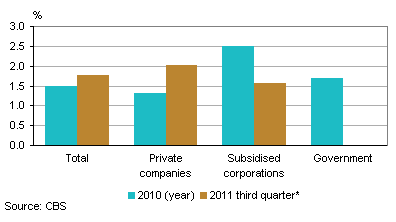Collectively agreed wage rates up 1.3 percent in third quarter

Collectively agreed wage rates in the Netherlands were 1.3 percent higher in the third quarter of 2011 than in the same period last year. In the second quarter the rise was 1.1 percent. Inflation was 2.6 percent on average. For the fifth consecutive quarter the rise in wages is smaller than the inflation rate.
Collectively agreed wages and contractual wage costs per quarter

Wages down in education
Education was the only sector in which wages decreased in the third quarter of 2011. Collectively agreed wage rates were 0.2 percent lower than twelve months previously. The main reason for this was a one-off payment agreed for university staff last year, but not this year. In addition, hardly any rises were agreed in the recent negotiations for this sector.
The term of more than half of the collective wage agreements in this sector has now ended, as no agreement has yet been negotiated between employers and the unions.
Highest rise in transport and communication
With a wage rise of 2 percent, transport and communication had the largest wage rise in the third quarter of 2011. This is double the increase in 2010. Some agreements in this sector comprise wage increases of more than 2.5 percent in 2011
Wage rises by sector

Contractual wage costs 1.8 percent higher
Contractual wage costs were 1.8 percent higher in the third quarter of 2011 than twelve months previously. This rise is 0.2 of a percent point larger than that in the second quarter and was caused by the higher wages. For the collective labour agreement sectors private companies and subsidised corporations the increases in wage costs in the third quarter were 2.0 and 1.6 percent respectively.
Contractual wage costs by collective labour agreement sector

Terms of most collective agreements have now ended
No third quarter figures are available for the government sector. This is because the terms of most agreements for this sector have ended and negotiations between employers and the unions have not yet been concluded. Government employers want to freeze wages, while the union representatives want at least an increase to retain the level of purchasing power.
At the end of the third quarter of 2011, wage developments were known for three-quarters of collective agreements for the current year. There are large differences between the sectors. In the government sector, wage developments are known for only 44 percent of collective agreements.
For private companies, 82 percent of agreements have been negotiated. Based on these agreements, the wage increase in this sector is calculated to be 1.3 percent.
Monique Hartog